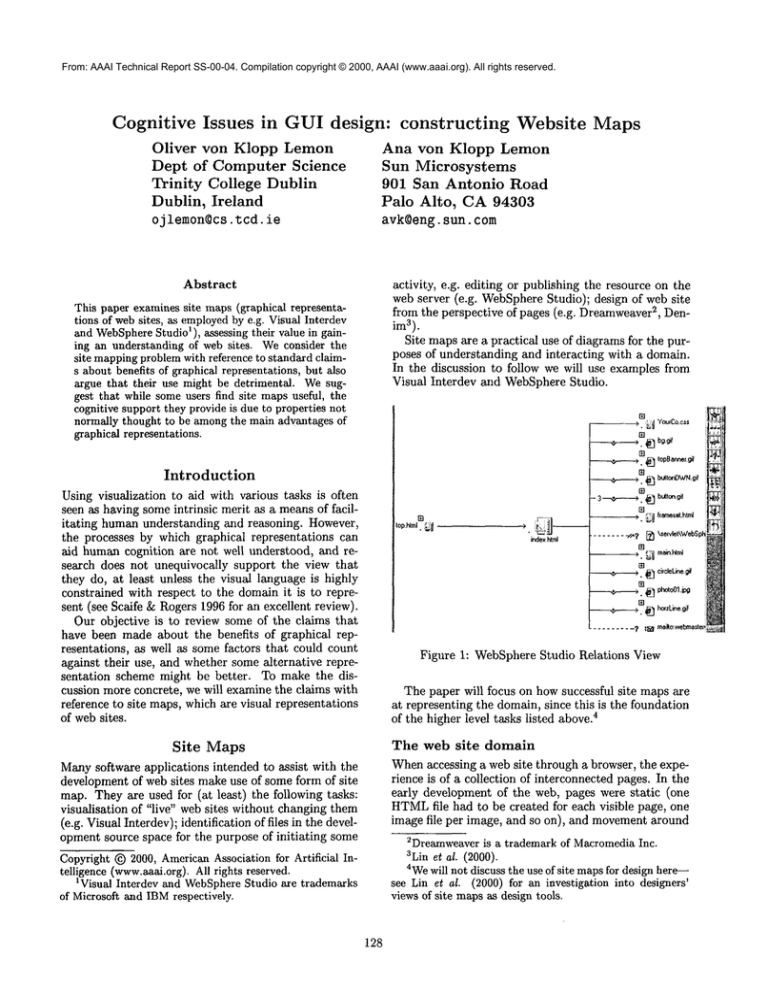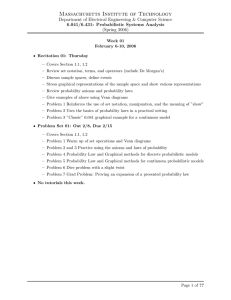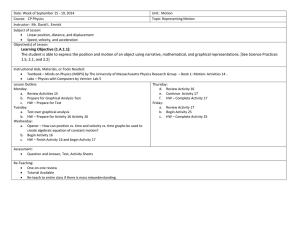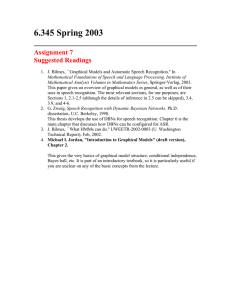
From: AAAI Technical Report SS-00-04. Compilation copyright © 2000, AAAI (www.aaai.org). All rights reserved.
Cognitive
Issues
in GUI design:
Oliver
yon Klopp Lemon
Dept of Computer
Science
Trinity
College
Dublin
Dublin,
Ireland
oj lemon©cs.tcd. ie
constructing
Website Maps
Ana yon Klopp
Lemon
Sun Microsystems
901 San Antonio
Road
Palo Alto,
CA 94303
avk©eng, sun. com
Abstract
activity, e.g. editing or publishing the resource on the
web server (e.g. WebSphereStudio); design of web site
2, Denfrom the perspective of pages (e.g. Dreamweaver
im3).
Site mapsare a practical use of diagrams for the purposes of understanding and interacting with a domain.
In the discussion to follow we will use examples from
Visual Interdev and WebSphere Studio.
This paper examinessite maps(graphical representations of websites, as employedby e.g. Visual Interdev
andWebSphere
Studio1), assessing their value in gaining an understanding of web sites. Weconsider the
site mappingproblemwith reference to standard claims about benefits of graphical representations, but also
argue that their use might be detrimental. Wesuggest that while someusers find site mapsuseful, the
cognitive support they provide is due to properties not
normally thought to be amongthe main advantages of
graphical representations.
v+
¯
Introduction
Using visualization to aid with various tasks is often
seen as having some intrinsic merit as a means of facilitating human understanding and reasoning. However,
the processes by which graphical representations can
aid human cognition are not well understood, and research does not unequivocally support the view that
they do, at least unless the visual language is highly
constrained with respect to the domain it is to represent (see Scaife &Rogers 1996 for an excellent review).
Our objective is to review some of the claims that
have been made about the benefits of graphical representations, as well as some factors that could count
against their use, and whether some alternative representation scheme might be better. To make the discussion more concrete, we will examine the claims with
reference to site maps, which are visual representations
of websites.
Site
~
[~
>.~-:~’~Yo,mCo.cs~
ff]
bg.gif
).
[3
).~ topBanner.gif
[]
buttonD".MN.gif
E]
index
html
........,,,,.?
El
>. ~-~]main.~afi
cilcleLifle.
~i~
)~.~ pho~o01.i~
m
hofzLine.gif
.........
? ,’~i~
Figure 1: WebSphere Studio Relations View
The paper will focus on how successful site maps are
at representing the domain, since this is the foundation
4of the higher level tasks listed above.
The web site
domain
Whenaccessing a web site through a browser, the experience is of a collection of interconnected pages. In the
early development of the web, pages were static (one
HTML
file had to be created for each visible page, one
image file per image, and so on), and movementaround
Maps
Manysoftware applications intended to assist with the
development of web sites make use of some form of site
map. They axe used for (at least) the following tasks:
visualisation of "live" web sites without changing them
(e.g. Visual Interdev); identification of files in the development source space for the purpose of initiating some
2Dreaxaweaveris a trademark of MacromediaInc.
3Linet al. (2000).
awewill not discuss the use of site mapsfor designhere--see Linet al. (2000) for an investigation into designers’
viewsof site mapsas design tools.
Copyright (~) 2000, AmericanAssociation for Artificial Intelligence (www.aaai.org).All rights reserved.
1Visual Interdev and WebSphereStudio are trademarks
of Microsoft and IBMrespectively.
128
the site was controlled by the user through explicit
links. As technology has progressed, pages can now also contain forms with submit buttons which cause user
input to be processed on the server, or small interactive
applications. Technologies such as CGIscripts, NSAPI,
Servlets, JSP, and ASP, allow the content of a visible
page to adapt to user input, and data can be maintained
in the background as users move around the site.
Dynamicgeneration of pages adds complexity to the
domain, since there is no one-to-one correspondence between pages and files on the server. A program which
contributes to the web site’s functionality could generate zero, one, or several visible pages, or it could generate text or pictures that will becomepart of one.
Constructing
a site map
Creating a site map involves two steps: generating complete data about the domainstate 5, and creating an intelligible two-dimensional graph which adequately represents this data.
Considering the first step, if a web site consists only
of static files, with statically defined navigation links
and references to other files, then this task simply
amounts to parsing HTMLfiles for relevant HTML
tags. This is not entirely without complexity. For instance, it involves detecting circularity (a page can have
a link to another page which links back to the first one
through a chain). Also, most web servers are configured to serve files of particular namesas default (usually index,htmlif an incoming request only contains
a path name). In that case, http://theserver/path/
and http://theserver/path/index.html
refer to the
same resource (provided /path/index.html
exists),
which means that the parsing algorithm needs to be
able to resolve such ambiguities.
The Visual Interdev parsing algorithm detects neither of these problems, in fact all URLsare treated
as referring to a new resource. Most web sites contain
more than one link to at least somefile, so Visual Interdev graphs almost always contain multiple references to
the samefile, causing portions of the site to be repeated
in the diagram.
If the the web site relies on dynamic generation of
pages, however--specifically dynamic generation of the
navigation links--then automatic discovery of all dependencies is difficult or even impossible. This is true
regardless of whether the parsing algorithm inspects the
program files or the generated pages. There are many
reasons for this; we will only mention a couple for the
purposes of illustration (both examples come from real
websites).
¯ Navigation from the entry page of the site is often
presented to the user as a menu. This menu might
5Strictly speaking, generation of domaindata is not an
aspect of graphical representations. This step is required for
other representations as well. It is howeverrelevant to the
question of whether a graphical representation is the most
appropriate interface given the informationusers are intended to gather from site maps, and so is worth examination.
129
be generated by a program that detects the presence
of particular files when the user accesses the site.
The links that the menu program produces are never present in the program source, so they would be
missed if that is what the parsing algorithm inspects. Even when there is no dependency on an external
state, links that are calculated on the fly maybe difficult to identify for the parser.
WebSphere Studio, which generates data by parsing
source files, fails to find dynamicallygenerated links,
although if the user knows about them, they can be
entered into the representation afterwards.
¯ Programs may generate different sets of pages depending on an external state. Say that a web application contains a set of forms which allows the user
to administer printing on a remote server. Users can
choose to set up, stop or restart the print services;
add new printers; removeor delete existing printers.
Which of these options make sense, and hence show
up on the form, varies depending on what the current
state of the system is. This application starts with
a menupage with links to the subset of all possible
pages corresponding to the tasks that makesense given the current state of the system. The links are references to different programs, each of which generate
a form appropriate to the task in hand. If the parsing
algorithm inspects a live site, it will only detect the
subset of links that is generated for the current state
of the remote system. The algorithm would miss several pages, and hence the presence of objects on the
web servers.
Since Visual Interdev parses the live site, it misses
pages that are generated this way unless the user ensures that the programs have access to all possible
states. However, since the parser cannot detect multiple references to the same resource, it cannot detect
when that resource generates alternate pages. While
all the alternate pages would be shown, the fact that
they correspond to the same URLis not.
The second step in website mapping, creating a a two
dimensional graph which represents the domain data,
turns out to be highly problematic. Firstly, the domain
data might not correspond to a planar graph. This
is already true for statically defined navigation links-consider a domainconsisting of five pages, each of which
has links to the other four--and the domain contains
other features which give rise to non-planarity as well,
e.g. different types of disjunction (navigation routes and
generation choices). Secondly, the number of objects
and relations in the domain can be very large, which
wouldrequire a large and cluttered display. Thirdly, the
domain is such that the different types of disjunction
need to be represented at the same time. Consider the
example of the printer administration forms above. The
menupage features disjunction of two types: the user’s
choices (which of the available tasks/navigation links
to follow), and which of the possible tasks were shown
given the state of the system. This difference (what
alternative pages can be generated, as well as which
Possible
links are available on each one) should be represented
if the diagramis to reflect navigation in the website.
A graph that represents a whole site is likely to be
too complex to either display or interpret, so both Visual Interdev and WebSphereStudio use strategies that
allow users to inspect a subset of the domainat a time.
These will be discussed in section below.
Some benefits
of graphical
disadvantages of graphical
systems
The possibility that for some tasks, graphical representations may be less suitable than sentential ones, or
even detrimental, is rarely raised in the theoretical literature (though see Scaife & Rogers 1996 for cognitive
issues, and Lemon& Pratt 1997 for formal arguments).
In practice, whenit comesto designing real applications, some of these problems are well known, so software
designers have developed a set of standard strategies to
work around them, which often involve restricting the
portion of the domain that can be viewed at any one
time.
This section discusses properties of some domains,
visual languages, and tasks, which makeit difficult to
design suitable graphical systems, and may hence count
against using diagrams in those circumstances. Wealso consider the commontechniques for working around
such problems, and assess what the trade-offs of these
are.
systems
There axe several types of argument for whyvisual representations could be better than sententiai ones. For
example, in somegraphical representations the activity
of constructing a diagramin itself is claimed to help the
user reason about a problem domain. This is thought
to be the case when a visual language is such that it
cannot represent impossible states of the domain; or if
the act of representing a set of premises automatically
causes all their valid conclusions to be represented (as
has been argued for Euler Circles).
With respect to the site maps considered here, users
do not themselves construct the diagrams. However,
the notion that the diagram might automatically represent all true facts about the domainstill has an interpretation. In practice it means that whatever facts
the user needs to know about the domain are available
by inspecting the diagram--there is no need for them
to do any additional inference work.
Another property of graphical representations which
potentially confers a cognitive advantage over sentential
ones is that they mayallow representational objects to
participate in two or more semantic relations simultaneously, thus being more "compact" and easier to read
than sentential systems. 8 If the layout of the diagram
permits, and it is appropriate for the domain, users
should also be able to detect patterns of such relations
across several objects.
Conflict
between
design reality
user
assumptions
and
It is a feature of some formal systems that they conform to the closed world assumption--if a relation is
not represented, then its negation holds; if an object
is not represented, it does not exist. Natural language
is such that neither in production, nor in interpretation
do we assume that the closed world assumption applies.
However, users of graphical systems mayfind it natural
to adopt the closed world assumption (Levesque 1988)
when reasoning with them, which is what many users
appear to do.
This factor is relevant in the context of site maps, because as pointed out above, it is not possible to devise a
fail-safe algorithm for inferring domaindata about web
sites (site mapsare not unique in this respect, this is
also true for e.g. two-wayUMLapplications). In other
words, information derived from the site mapis not reliable. A user whobelieves that a site maprepresents the
entire web site may derive erroneous information from
it, while a user who is aware that it is incomplete can
only use it for guidance--if the information is essential,
it has to be confirmed through other means.
At least some users are aware of incompleteness as
a generic problem of software which employs graphical
representations, but still consider such interfaces valuable. Since incompleteness would seem to cancel many
of the supposed benefits of graphical representations.
This raises the question, which we return to below, of
what does make them desirable.
With respect to site maps, these general points translate into some specific possibilities.
With regard to
compactness, for instance, a site map may simultaneously showall pages that have links to a page P, and all
the pages to which P has links (only the latter would be
found by inspecting P’s source). This can be represented sententially in a format that is as easily accessible
as a diagram, but only with reference to resources one
link away. To represent the branching at the next level, at least somegraphical annotation (e.g. indentation)
seems necessary to make the sentential representation
as readable as a diagram. The ability of site maps to
show several objects and their relations at the same
time means that the user can detect where pages exhibit systematic navigation patterns, allowing for better
organisation both of the site and of navigation.
Expressivity
and inferential
problems
There are formal results which show that some graphicai systems are unsuitable for the tasks they were designed for (Lemon &: Pratt 1997; yon Klopp Lemon
2000). For instance, the system might not be able to
represent all the structures required by the application
6Suggested by Kathi Fisler at the First CSLI workshop
on Visual Reasoning, 1999.
130
domain, or it might lead the user to generate incorrect inferences. This happens even with commonand
simple systems, such as Euler Circles for representing
statements about sets.
A generic problem with graphical representations is
that they are ill-equipped to encode NECATION,7 i.e.
there is no practical way to express absence other than
relying on the closed world assumption. It was pointed
out above that absence cannot be reliably interpreted as
negation with site maps, since the data they are based
on is likely to be incomplete. But this is not the only
problem--not being able to represent negation explicitly also meansthat there are certain types of query that
are not easy to answer by referring to diagrammatic
representations. While diagrams can be effectively used
to answer questions such as "Which of the HTMLfiles
use this style sheet?", answers to questions such as "Do
all the HTMLfiles reference this style sheet?" or "Do
any of the HTMLfiles not reference this style sheet?"
are harder to find. In contrast, results for this type of
query can easily be reported and interpreted sententially, perhaps with the additional benefit that the user is
less likely to assumethat the representation is complete.
The problem of expressing negation can be ameliorated somewhat(though it is by no means solved) by using
FILTERS. Both Visual Interdev and WebSphere Studio
offer the user the possibility of screening out certain
types of object, so that the diagram only shows HTML
files for instance. By applying filters, the user maybe
able to display only objects of the relevant categories,
which may enable the absence of tokens to be detected more easily. The risk associated with using filters is
that the user fails to spot significant facts that involve
objects or relations that have been filtered out.
Generalization
problems
The repertoire of symbols that can make up a visual
language is subject to restrictions that are not present
in sentential languages. There is a natural tendency to
categorise the symbols (lines, regions, etc.) and if the
language employs too many types from the same category (e.g. different types of line or differently colored
squares), they become hard to distinguish. Such distinctions must also be kept in working memorywhile
interpreting the diagrams.
Under the right conditions, this tendency to correlate categories of diagrammatic object with categories
in the domain can be exploited to make the diagram
easier to understand. For domains which feature many
different types of objects and relations, however, that
same tendency can be problematic: objects or relations
in the domain which should not be categorised together
may have to be represented by symbols of similar spatial types. This can lead to unwarranted assumptions
about similarity: for example, if A and B are represented by the same type of symbol, but do not belong to the
same category in the domain. The converse problem, of
failing to detect category membership,can also arise.
Consider for instance a site map which shows both
navigation links in a page and inline links to e.g. an image or a program whose output is displayed within the
page. These relations are conceptually different: if a resource referred to in an inline reference is missing, the
page does not display as intended; if a resource referred
to in a navigation link is missing the page displays correctly, but does not function as intended in the sense
that the user cannot follow the broken link. The formal properties of both these relations (navigation and
inline links) are such that the only sensible graphical
srepresentation of them is as lines connecting regions,
Thus the graphical types in the representation fail to
distinguish different object types (e.g. different kinds of
dependencies, or links) in the domain.
Commonstrategies
for avoiding problems arising
from the restricted repertoire of visual languages are
filtering (discussed above), or by adding somenotational convention to the spatial symbol, e.g. symbols such
as arrowheads or kinks on lines; color; or even textual annotation. Visual Interdev and WebSphere Studio
employboth. Filters are used to categorize objects, and
notation is used to distinguish between different types
of relations (Visual Interdev uses color; WebSphereStudio symbols) as well as different types of files (which
can be recognized by their file extensions).
Adding notational conventions to an already complex
diagram is likely to makeit more difficult to interpret.
It may also require the user to perform additional processing since the annotated objects have a more complex semantics. Stenning & Lemon(2000) explored the
possibility that an advantage of at least some types of
graphical representations over other types of representation is that users do not have to perform the equivalent of syntactic processing. This would make them
easier to use than e.g. sentential representations. Clearly, any such advantage is lost if the visual language is
augmented with annotation.
It is also relevant that the user will need to maintain
the meanings of the annotations ("blue" means functional navigation link, "red" means broken link, etc.)
in working memory.This adds to the effort of processing the diagram. This is an area where graphical representations mayinvolve a type of processing that does
not arise with familiar sentential representations, since
with the latter it is normally possible to use mnemonic
names for the objects and relations.
Size/layout/graph
complexity
problems
The problems with generating graphs for site maps were
surveyed above. To summarise, the graph is likely to
contain a large number of tokens, potentially features
complex disjunction, and might be non-planar.
Humansare reasonably good at scanning sequential
lists, but scanning a two dimensional representation for
TTheliterature also often mentions disjunction, but for
the site mapdomainat least, this is complexity problem,
not a notational one.
SThese issues will be explored in von Klopp Lemon&
yon Klopp Lemon(2000).
131
information is harder. For information gathering tasks
that would involve scanning an entire diagram for a
particular graphical feature, it is therefore likely that a
sentential representation would be more effective. Consider the task of identifying and correcting broken links.
Both Visual Interdev and WebSphere Studio represent
broken links. However,a sentential list consisting only
of descriptions of where the problems are (the parsing algorithm has clearly generated this data) would be
considerably more helpful to the user2
Non-planar graphs cannot be constructed in two dimensions without assigning null semantics to certain
graphical relations. For site maps this means that if
the diagram represents pages/programs as regions and
relations as lines, it is necessary to allow lines to cross
each other without the crossing having any meaning in
terms of the relations. This obviously makes the diagramharder to interpret since it is moredifficult to follow lines that cross each other than ones that do not.
Another reason whythis might be relevant is that it has
been claimed that graphical representations are easier
to interpret than sentential ones precisely because every
graphical relation corresponds to a relation holding between domain objects, and hence that the user need not
expend any effort on determining which aspects of the
representation are significant and which are not. Finally, there is somedanger if null semantics is implicit. In
another domain, crossing lines may be meaningful (consider a mapwhere lines denote paths) so such decisions
may not be transparent to the user.
A commontechnique for avoiding planarity problems is to use a stepping mechanism. This is what WebSphere Studio does: its display is centered around a
single object, and shows all objects which dependon it,
and all objects on which it depends (see Figure 1). Although this strategy successfully avoids non-planarity,
it also severely restricts the numberof pages and relations the user can survey at any one time. This means
that it does not help the user to detect patterns and
cycles in the site as a whole. Moreover, as pointed out
above, this amount of information can be represented
sententially in a way that is equally accessible as the
graphical one.
Visual Interdev does not, as it were, need to employa
strategy to avoid non-planarity. Since it fails to detect
when two URLsrefer to the same resource, the problem
does not arise in the first place. Of course, this feature
also makes it unusable for detecting patterns.
least one task (that of identifying broken links) would
be better supported by a sentential representation.
Despite these shortcomings, manyusers still consider
site maps to have some merit, even if they are aware of
their limitations. This suggests that while the literature
describes diagrams in terms of supporting inference, in
practice users find other types of benefits, at least in the
domain of site maps. Wesuggest that the main advantages conferred by the use of site mapsare firstly, that
they provide an external representation of the resource
situation (which is useful even though it is likely to be
incomplete), and secondly that what is represented is
shown in a compact manner (as discussed above).
is worth exploring whether this could be the case with
other graphical systems.
Acknowledgements
Wewish to thank Kathi Fisler, George Fink and Suresh
Potiny.
References
Lemon, O., and Pratt, I. 1997. Logical and Diagrammatic Reasoning: the complexity of conceptual space.
In Shafto, M., and Langley, P., eds., 19th Annual Conference of the Cognitive Science Society, 430-435. New
Jersey: Lawrence Erlbaum Associates.
Lemon, O.; de Rijke, M.; and Shimojima, A. 1999. Efficacy of Diagrammatic Reasoning (Editorial). Journal
of Logic, Language, and Information 8(3):265 - 271.
Levesque, H. J. 1988. Logic and the Complexity of
Reasoning. Journal of Philosophical Logic 17:355-389.
Lin, J.; Newman,M.; Hong, J.; and Landay, J. 2000.
Denim: Finding a tighter fit between tools and practice for web site design. In Proceedings of CHI 2000.
(to appear).
Scaife, M., and Rogers, Y. 1996. External cognition:
how do graphical representations work? International
Journal of Human-ComputerStudies 45:185 - 213.
Shin, S.-J., and Lemon, O. 2000. Diagrams. Stanford
Encyclopedia of Philosophy. (in preparation).
Stenning, K., and Lemon, O. 2000. Aligning logical
and psychological perspectives on Diagrammatic Reasoning. Artificial Intelligence Review. (in press).
Stenning, K., and Oberlander, J. 1995. A Cognitive
Theory of Graphical and Linguistic Reasoning: Logic
and Implementation. Cognitive Science 19(1):97- 140.
von Klopp Lemon, A., and von Klopp Lemon, O. 2000.
The constraint matching theory of diagram design, in
preparation for submission to Diagrams 2000.
von Klopp Lemon, O. 2000. Comparing the Efficacy of Visual Languages. In Barker-Plummer; Beaver;
di Luzio; and van Benthem., eds., Logic, Language,
and Computation, Volume 3. Stanford: CSLI Publications. (under review).
Conclusion
Our objective was to survey graphical representations of web sites as user interfaces. The domain is very
complex, which makes it difficult both to generate accurate data and to generate a graph that represents it.
The tools take shortcuts, and employ simplification strategies, which have the effect that their usefulness for
understanding the domain is diminished. Moreover, at
9Since the displays showonly connecteddiagrams, filters
cannot be used to detect broken links.
132





